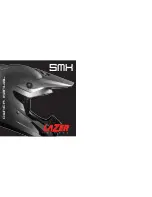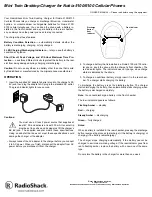
10 ENGLISH
Personal protective equipment
1.
Work gloves of stout leather are part of the
basic equipment of the tool and must always
be worn when working with it. Also wear
sturdy shoes with anti-skid soles.
2.
Wear ear protection such as ear muffs to pre
-
vent hearing loss.
3.
Wear protective goggles, safety helmet and
protective gloves to protect yourself from
flying debris or falling objects.
4.
When touching blades or adjusting the blade
angle, wear protective gloves.
Blades can cut
bare hands severely.
Operation
1.
Always use two hands to operate the tool.
Using one hand could cause loss of control and
result in serious personal injury.
2.
While operating the tool, always ensure that
the operating position is safe and secure.
Overreaching with the tool, particularly from
a ladder, is extremely dangerous. Do not work
from anything wobbly or infirm.
3.
Do not simultaneously wear multiple belt har-
nesses and/or shoulder harnesses when oper-
ating the tool.
4.
During operation, keep bystanders or animals
at least 15 m away from the tool. Stop the tool
as soon as someone approaches.
5.
If cutting tool strikes any object or the tool
starts making unusual noise or vibration,
switch off the tool and remove the battery car
-
tridge immediately and allow the tool to stop.
And then take the following steps:
•
inspect for damage
•
check for, and tighten, any loose parts
•
have any damaged parts replaced or
repaired with genuine spare parts.
6.
Only use the tool for its intended purpose. Do
not use the tool for any other purpose.
7.
Switch off the tool and remove the battery
cartridge before:
•
cleaning or when clearing a blockage,
•
checking, carrying out maintenance or
working on the tool,
•
adjusting the working position of the
shear blades,
•
leaving the tool unattended.
8.
Ensure that the tool is correctly located in a
designated working position before starting
the tool.
9.
Do not operate the tool with a damaged or
excessively worn shear blades.
10.
Always be aware of your surroundings and
stay alert for possible hazards of which you
may not be aware due to the noise of the tool.
11.
Be careful not to accidentally contact a metal
fence or other hard objects during operation.
The blade will break and may cause serious injury.
12.
Avoid unintentional starting. Do not carry the
tool when the battery cartridge is installed
and with finger on the switch. Make sure that
the switch is off when installing the battery
cartridge.
13.
Do not grasp the exposed cutting blades or
cutting edges when picking up or holding the
tool.
14.
Do not force the tool.
It will do the job better and
with less likelihood of a risk of injury at the rate for
which it was designed.
15.
Do not use the tool in the rain or in wet or
very damp conditions.
The electric motor is not
waterproof.
16.
Hold the tool firmly when using the tool.
17.
Do not operate the tool at no-load
unnecessarily.
18.
Before checking the shear blades, taking care
of faults, or removing foreign objects caught
in the shear blades, always switch off the tool
and remove the battery cartridge.
19.
Never point the shear blades to yourself or
others.
20.
If the blades stop moving due to the stuck of
foreign objects between the blades during
operation, switch off the tool and remove the
battery cartridge, and then remove the foreign
objects using tools such as pliers.
Removing
the foreign objects by hand may cause an injury
for the reason that the blades may move in reac
-
tion to removing the foreign objects.
21.
When attaching or removing the blade cover,
be careful not to injure your hands.
Electrical and battery safety
1.
Avoid dangerous environment. Don't use the
tool in damp or wet locations or expose it to
rain.
Water entering the tool will increase the risk
of electric shock.
2.
Do not dispose of the battery(ies) in a fire.
The cell may explode. Check with local codes for
possible special disposal instructions.
3.
Do not open or mutilate the battery(ies).
Released electrolyte is corrosive and may cause
damage to the eyes or skin. It may be toxic if
swallowed.
4.
Do not charge battery in rain, or in wet
locations.
5.
Do not charge the battery outdoors.
6.
Do not handle charger, including charger plug,
and charger terminals with wet hands.
Maintenance and storage
1.
When the tool is stopped for servicing, inspec
-
tion or storage, switch off the tool and remove
the battery cartridge, and make sure all mov
-
ing parts have come to a stop. Allow the tool
to cool before making any inspections, adjust
-
ment, etc.
2.
Always allow the tool to cool down before
storing.
3.
When not in use, attach the blade cover to the
tool and store the tool indoors in dry, and high
locked-up place, out of reach of children.
4.
Maintain the tool with care. Keep cutting edge
sharp and clean for best performance and to
reduce the risk of injury. Follow instructions
for lubricating and changing accessories.
Keep grips dry, clean, and free from oil and
grease.
Summary of Contents for EN422MP
Page 3: ...3 1 Fig 9 1 3 2 4 Fig 10 1 Fig 11 1 Fig 12 3 1 2 4 Fig 13 Fig 14 ...
Page 4: ...4 1 1 Fig 15 1 2 Fig 16 Fig 17 2 3 1 Fig 18 1 2 Fig 19 ...
Page 5: ...5 1 3 2 4 Fig 20 2 1 Fig 21 1 2 Fig 22 1 2 Fig 23 Fig 24 Fig 25 Fig 26 ...
Page 6: ...6 Fig 27 Fig 28 Fig 29 Fig 30 Fig 31 Fig 32 1 Fig 33 2 1 Fig 34 ...
Page 7: ...7 Fig 35 1 2 3 1 Fig 36 2 1 Fig 37 1 Fig 38 ...
Page 243: ...243 ...











































